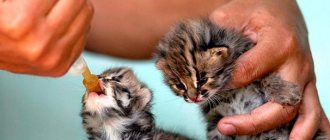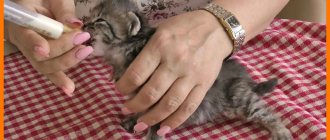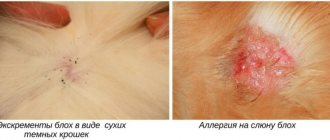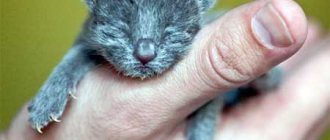Cesarean section is performed in cats in cases of obstructed labor. Often, during the intervention process, the veterinarian, at the request of the owners, not only removes the kittens from the uterus, but also removes the organ, as well as the ovaries, in order to prevent future unwanted pregnancies. The operation is considered simple, most cats tolerate it well, but the owner will need to provide the pet with proper post-operative care so that the rehabilitation period proceeds without complications.
What should you do with your cat immediately after a caesarean section?
The mother needs to be given a painkiller that will be eliminated from the body fairly quickly. Most cats recover from anesthesia by the time they are discharged from the clinic. Full recovery takes two to six hours, depending on the combination and quality of anesthesia used, the physical condition and age of the cat, and how long the animal was active before surgery.
During this period, it is necessary to constantly ensure that the cat does not fall and get hurt, or crush the kittens with her body.
During this period, it is necessary to constantly ensure that the cat does not fall and get hurt, or crush the kittens with her body. You can't leave her alone until she fully wakes up, gets on her feet and starts caring for the kittens.
After a few hours, the mother should begin to eat. Food and drink should be served in small portions every 15–30 minutes throughout the day after surgery. Too much food can cause your cat to vomit. During this period, it is necessary to serve one and a half times more food compared to what the cat ate before pregnancy. By the third to fourth week of breastfeeding, the cat should eat two to two and a half times more food. To ensure that the cat and kittens receive all the necessary microelements, it is necessary to feed the cat a high-quality diet throughout the nursing period.
Your cat should never be given paracetamol or aspirin.
The mother's temperature may rise 0.5-1°C above normal in the first three days, after which it should return to normal - between 38.1 and 39.2°C. Your cat should never be given paracetamol or aspirin. If the temperature rises above 40°C, it is necessary to take the animal and kittens to your veterinarian as soon as possible.
Complications after anesthesia
Anesthesia is necessary for a kitten in order to relieve pain shock, suffering and emotional stress. But not a single individual is immune from the development of complications after anesthesia.
For anesthesia of animals, drugs are used that have minimal toxicity and do not have a negative effect on the body. But anesthesia has its side effects:
- slows down metabolism in the liver;
- reduces body temperature;
- increases blood pressure;
- causes irregular heartbeat;
- an allergic reaction cannot be ruled out.
As a result of complications, heart failure, pulmonary edema or anaphylactic shock may develop.
Many veterinarian anesthesiologists recommend using gas anesthesia, believing that it is safe and does not cause any complications.
During the operation, the cat is under the supervision of doctors, but after the sterilization procedure the animal needs no less attention. You need heating pads to warm your pet , you need to provide him with peace and limit access to bright light. Many people leave the kitten in the hospital for some time after surgery to avoid various complications.
© shutterstock
To eliminate the possibility of complications after sterilization, an examination is carried out before the operation and possible risks are identified:
- laboratory blood test;
- Ultrasound of organs;
- ECG of animals that are at risk.
To ensure a successful operation and limit complications, the animal is prepared long before the procedure:
- vaccinations must be done no later than three weeks in advance;
- use of anthelmintic therapy;
- stop feeding the cat 12 hours before surgery.
The operation to sterilize a cat is considered safe; it saves the animal from disease, cancer and early death, but there are certain risks of complications.
Why do kittens scream a lot?
Kittens need to sleep or eat 90% of the time. If they scream or whine, something is wrong. Intrauterine infections, insufficient milk supply or poor quality are the main causes of tired or sick kittens. In case of complications, the entire brood may die within a day. If you have any doubts about the health of your newborns, take your kittens and cat to the veterinarian.
If the mother does not have enough milk at first, you can feed the kittens yourself for a day or two. Your veterinarian should recommend a cat milk replacer with a feeding bottle that fits kittens' mouths.
As a last resort, you can use the following recipe before purchasing a cat milk replacer:
Take 1 mug of cow's milk, 1 tablespoon of corn oil, a pinch of salt and 3 egg yolks and whisk until smooth. The daily portion size should be 30 milliliters per 125 grams of kitten weight. This volume should be divided into 3-5 servings. The average weight of newborn kittens is 125 grams. It is not advisable to feed kittens with this recipe for more than two to three days.
Although it is preferable to feed kittens right away, a healthy newborn kitten can survive without food for twelve hours. However, if the kitten is weak, dehydrated or cold, you need to feed it as quickly as possible.
What is it used for?
Caesarean section is especially often used in first-born and very old cats. In the first case (especially if the kittens are from a large cat), the diameter of the birth canal may be too small for a natural and safe birth, and in the second, the old animal may not be able to withstand the “natural” course of this process. In addition, indications for the use of this surgical intervention may be pathologies in the development of fetuses identified by ultrasound or their exceptionally large size. In addition, if one or two kittens lie completely across the birth canal, it will almost certainly not be possible to do without a caesarean section.
In very rare cases, it happens that due to some kind of hormonal imbalance, a cat simply cannot have a natural birth. This threatens post-maturity and death of the fetus, and therefore surgery may be the only way out of this situation.
When should kittens be weaned from their mother?
Kittens can begin weaning approximately three and a half weeks after birth. The first step is to pour a 1:1 mixture of water and cat milk replacer into a flat plate next to the kittens; cow's and goat's milk will not work. Kittens need to gently rub their nose into this mixture two to three times a day until they begin to lap it up. Once they are used to the milk replacer, you can start adding kitten food. Gradually, the cat's milk replacer should be completely replaced by canned food. Once they start eating solid food (this is approximately the sixth week of life), the kittens can be rehomed. However, for development and socialization purposes, it is best to keep the kittens with their mother for 8–10 weeks from birth. This will help reduce potential personality problems in the kitten caused by separation from the litter too early.
The first day after surgery
After surgery, the pet can be left in the hospital or taken home immediately. In the second case, it is necessary to understand all possible nuances, since responsibility for the health of the furry patient falls on the owner. Also, the most popular option for sterilization at home remains.
Hospital
Most veterinary clinics offer to leave the animal in their hospital during recovery. This eliminates the need for independent manipulation and guarantees emergency assistance if complications arise.
The disadvantages of this option include the high price and psychological factor. If a pet is strongly attached to its owner, then it will be difficult for her to be left alone in an unfamiliar place. In addition to stress, she may harbor resentment, which will change her behavior forever. There is also always the risk of unscrupulous personnel. You won’t be able to track their work, so it’s safer to trust yourself.
Delivering a cat home
If you decide to take care of your pet at home, prepare for it a warm blanket, disposable diapers and a comfortable carrier. Sometimes a veterinarian will hand a furry patient over to her owners after she regains consciousness. He also needs to make sure the bleeding stops.
After receiving your pet from the doctor’s hands, place her on her right side in a carrier with diapers and cover her with a blanket. This position reduces the load on the heart and prevents vomit from entering the trachea if the cat suddenly feels nauseous. And this happens often after anesthesia.
Coming out of anesthesia
After returning home, place the pet on a soft bedding located on the floor and warm it with a heating pad. Anesthesia disrupts natural thermoregulation and coordination. Without your help, the animal may freeze or get injured if it gets up from an uncomfortable place.
Also make sure you have diapers. Before complete awakening, involuntary bowel and bladder emptying is possible.
If you took your pet without waiting for her to wake up, then you will have to take care of moisturizing her eyes. Animals under anesthesia often have their eyes open but cannot blink them. Because of this, the mucous membranes dry out and become injured. For hydration, you will need to periodically close the cat's eyelids or hydrate the cornea with "artificial tears."
After awakening, attempts to escape are possible in order to hide in an inaccessible place. This occurs due to a lack of coordination and lack of understanding of the events taking place. Try to calm your pet down with affection and conversation. On the first day, keep an eye on her to help if necessary.
Is it possible to feed and water a cat?
Eliminate feeding for one day, but do not forget to give the animal water immediately after waking up. To be safe, use a syringe and watch your swallowing movements. In their absence, your pet may choke.
On the second day, offer food, but no more than ⅓ of the usual portion. By this time, the pet will begin to drink on its own. Interest in food appears on the second or third day. Increase the number of servings gradually, offering low-fat and easily digestible dishes.
It happens that a cat demonstrates severe hunger already in the evening of the first day of surgery. Then you can give her some low-fat broth. Dairy products and solid food should not be given - the animal is likely to vomit.
When can kittens become infected with parasites?
As a rule, endoparasites enter the body of kittens either before birth in the womb or through mother's milk after birth.
As a rule, endoparasites enter the body of kittens either before birth in the womb or through mother's milk after birth. Kittens can begin to suffer from parasites (helminths) at two weeks of age, but most often the parasites begin to make themselves felt between the third and sixth weeks. When treating for parasites, it is necessary to weigh kittens to determine the exact dosage of medications.
Care by day
During rehabilitation, it is recommended that one of the household members take a vacation. Usually a week is enough for complete recovery.
The instructions for caring for a cat after sterilization on a daily basis are simple. If at least one of the points does not correspond to the current situation, contact your veterinarian. Any deviation is a serious cause for concern.
First day
On the first day, refuse feeding and force-drink your pet using a syringe or pipette. Do not allow active movements and regularly moisturize the cornea. Monitor your bladder and bowel movements. If your pet intends to do this in the tray, place a towel under it to increase the stability of the limbs. You can simply hold the animal.
Lack of appetite, lethargy, vomiting and spatial disorientation are natural signs that accompany recovery from anesthesia. If pain occurs, contact your doctor and discuss acceptable analgesics. Increased aggression, frequent meowing and prolonged lack of movement will help you learn about unpleasant sensations.
Second day
Lack of bowel movements on the second day is a cause for concern. You will also have to contact your doctor if you are unable to move.
The pet should begin to move around and show interest in the water. Offer her some kefir or chicken broth. If you use dry food, temporarily replace it with wet food.
Limit movement within one room. It should contain a sleeping place, a tray, and feeders. Avoid freezing and rub the paws if they do not warm up on their own. You can also apply a heating pad to them.
The third day
By the third day the pain completely disappears. The animal becomes more active and begins to be interested in food. Increase your portions, but don’t rush back to your usual sizes. Let's eat more often, but little by little.
Measure your body temperature in the morning and evening. If both times are higher than normal, contact your veterinarian. This situation often requires antibiotics. Too low values are no less dangerous.
In case of prolonged absence of bowel movements, it is recommended to take laxatives. They accelerate intestinal peristalsis and stimulate fecal waste. You can find out which laxatives your cat can use by calling your veterinarian.
Fourth day
By the fourth day, the condition will completely stabilize, but to be on the safe side, it is recommended to continue to limit the space. Lack of bowel movement for more than 3 days requires urgent veterinary intervention. Don't try to solve the problem yourself and seek help.
Fifth day
On the fifth day, the animal can be released for walks in the yard or in other rooms. All this time, do not forget to monitor his safety. From this day on, the first jumps on low surfaces are allowed.
When examining the wound, scarring may be detected. Swelling and redness should disappear.
Sixth and seventh days
Behavior is completely normalized. In the absence of inflammation and suppuration on the wound, removal of the suture material is allowed.
If the cat was operated on laparoscopically, jumping and movement are allowed already on the 2-3rd day. The small seam does not come apart and does not cause severe discomfort to the cat. However, its sterility must be monitored no less carefully.
When should you get vaccinated?
To reduce the possibility of infection, defenseless kittens should be quarantined.
Primary vaccination takes place between the sixth and eighth weeks of a kitten’s life and depends on individual characteristics. If kittens are not nursed in the first three days of life, they will not receive sufficient immunity from their mother. Likewise, if the mother of the kittens was not vaccinated before birth, she may not pass on immunity to major viral diseases to her kittens. In such situations, your veterinarian may advise starting the vaccination program earlier, and the kittens should be quarantined to reduce the possibility of infection. All kittens need 2-3 sets of vaccines to enhance active immunity against common infectious diseases.
Technique
After removing the uterus from the peritoneum, the doctor must make an incision in it to remove the babies.
Before removing the kittens from the uterus, the veterinarian gives the cat general anesthesia. Then the doctor proceeds directly to the operation, following the following algorithm of actions:
- An incision is made on the side of the peritoneum.
- Takes out the uterus.
- Makes a cut in it.
- Retrieves kittens.
- Removes the umbilical cord and amniotic membrane.
- Gets rid of afterbirth in the uterus.
- Treats the organ with an antiseptic.
- Sews up the uterus.
- Returns it to its original position.
- Places stitches.
Post-operative diet
In the first few days, you should follow such an important recommendation as proper feeding, aimed at restoring the body. Your cat should be given low-fat chicken broth. Under no circumstances should you offer your animal dry food. Clean water should always be available.
After 3 days, your pet can be given meat puree. It's best if it's baby food. After a week, you can transfer the animal to specialized food intended for pets after sterilization.











